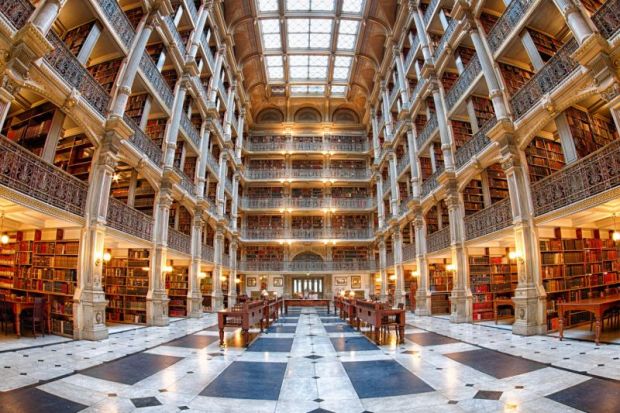Johns Hopkins University, after long insisting that its namesake founder was a pre-Civil War abolitionist, has admitted he held slaves and that the family biography it touted now deserves greater scrutiny.
University leaders described their findings – reflected in US census records from the mid-1800s discovered by two Hopkins historians – as part of a retrospective project it originally commissioned in 2013.
For years, Hopkins – an academic powerhouse perennially ranked the top US university by research spending – described its creator with pride as “an entrepreneur and abolitionist with Quaker roots who believed in improving public health and education in Baltimore and beyond”.
The institution’s current president, Ronald Daniels, joined top university officials in admitting shock at the discovery and a determination to keep working to learn a fuller truth of Mr Hopkins and his life.
The investigative team, the university acknowledged in a series of statements, found that Mr Hopkins owned at least four slaves, and found “no evidence to substantiate” its longstanding descriptions of him as an abolitionist.
The leader of that research team, Martha Jones, a professor of history, in an interview with Times Higher Education, gave a mixed assessment of whether the university should have been more careful in its effusive portrayal of its founder.
Professor Jones acknowledged that checking census records to see if slaves were listed by Mr Hopkins as part of his household could have been a fairly basic investigative step. “At the same time,” she said, “one would have to have a reason to reach for that tool.”
Yet Richard Cellini, the founder of a project that in 2016 discovered the sale by Georgetown University of more than 300 enslaved people in 1838, was unequivocal.
“This should have been discovered long ago,” said Mr Cellini, a technology executive and Georgetown alumnus.
“There’s nothing special or magical about the documents that have recently been ‘discovered’ by the Hopkins team,” he said. “In my experience, when it comes to finding evidence of university complicity in slavery, the hard part isn’t the finding. The hard part is the looking.”
Hopkins began its retrospective project in 2013, around the same time the University of Virginia led much of US higher education in forming a commission to explore its historical relationship with slavery and enslaved people.
Dozens of institutions in the US and abroad followed suit, generating widespread recognition of slavery’s role in financing the founding and development of large segments of US higher education.
Hopkins has only now joined that group, Universities Studying Slavery, as part of its response to the findings of Professor Jones and her colleague Allison Seyler, a historian and library manager at Hopkins.
In the early years of its retrospective project, however, Hopkins made little if any mention of investigating the possibility of slave ties or challenging the laudatory biographical sketch of its founder by his grandniece that the university published in 1929 and embraced thereafter.
Instead, the university described the retrospective project as tackling such questions as the historical siting options for the Hopkins summer estate, and the football team’s 1948 decision to skip a major post-season game.
Professor Jones came to Hopkins in 2017. She said she could not comment on why the university didn’t look sooner and harder at its founder, but suggested little surprise that a wealthy Baltimore merchant of the mid-19th century might have held people in slavery.
“None of what we found is categorically a revelation for me, but the particulars, of course, are a revelation for many people,” she said.
“Certainly in his grandfather’s generation, and the generations preceding that, Hopkins came from a family of planters in Maryland, whose wealth was derived to an important degree through the uncompensated labour of enslaved people,” Professor Jones said. “That we’ve always known, even if the particulars of it were a little jumbled.”
Mr Hopkins died in 1873 and left $7 million (about $150 million, or £110 million, now) – the nation’s largest philanthropic gift at the time – for the creation of the country’s first research university and an accompanying hospital.
Among their official statements on the matters, Hopkins leaders said they plan to investigate why their institution relied “for so long on the narrative of Mr Hopkins as an early and inveterate abolitionist, without fully investigating and verifying such claims”.
University officials said their list of unanswered questions in the matter also includes learning the names of the enslaved people and the work they performed, and clarifying details of Mr Hopkins’ support for President Lincoln and the Union during the Civil War.
The evidence of political activity by Mr Hopkins “is slim, but appears to show him aligned with the Union and participating in Union-leaning political organisations”, Professor Jones said. “There’s no sign that he was a Confederate sympathiser or supporter.”
Register to continue
Why register?
- Registration is free and only takes a moment
- Once registered, you can read 3 articles a month
- Sign up for our newsletter
Subscribe
Or subscribe for unlimited access to:
- Unlimited access to news, views, insights & reviews
- Digital editions
- Digital access to THE’s university and college rankings analysis
Already registered or a current subscriber? Login







